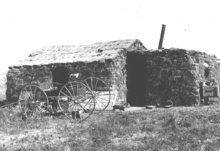Sod house
A turf house (also known as a peat plague house or, in general, a plague hut ) is a permanent dwelling, the wall fillings and roofing of which are predominantly made from stacked grass sods or, in the case of peat plague huts, from dried peat plagues that were cut on site. Buildings using this technology were and are usually in places with extreme climatic fluctuations and where other building materials such as wood or stone are not available.
Central Europe
In Central Europe, especially in Northern Germany and the Netherlands, peat plague huts were common in peatland colonies from the 18th to the early 20th centuries. There the mostly poor colonists had no funds for expensive house constructions, so they used the building materials available on site.
Iceland
In Iceland houses were dug into the ground, thereby accruing turf were piled up on walls. Even churches were built like this.
North Sea coast
Grass sods were also used as building material in Rungholt , North Frisia .
North America
In North America , when settling the prairie , sod houses were often used as cheap first housing when there was no easily accessible wood or stone as a building material. Since the Homestead Act stated that you could buy land just by building a home there and cultivating the land for five years, turf houses on the North American prairies often served as the nucleus of a property . The thick and comparatively deep roots of the prairie grass gave the walls a good hold. Although these offered good insulation, they kept the room climate rather humid. None of these buildings appear to have survived.
Web links
- Sigríður Sigurðardóttir: Grass sods for building houses . Small writings from the local history museum in Skagafjörður XV on glaumbaer.is, translated by Marion Lerner (PDF file, 1.7 MB. Accessed July 27, 2018)
- The Plaggenhütte on interest group for history and nature Bönninghardt 1991 eV
- Peat plague hut from the Nordloher Moor moor colony around 1913 on Kirchheim Radelsdorf
- Núpsstaður
- Víðimýri


